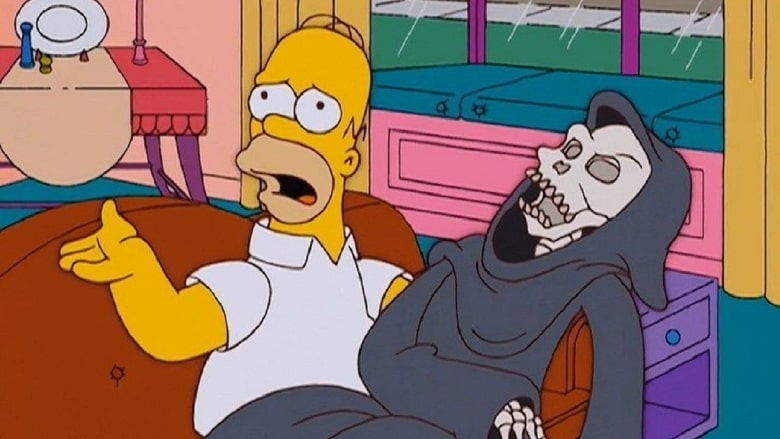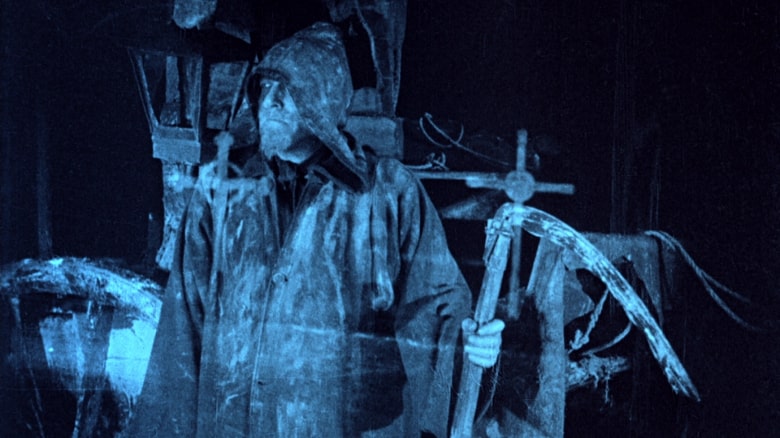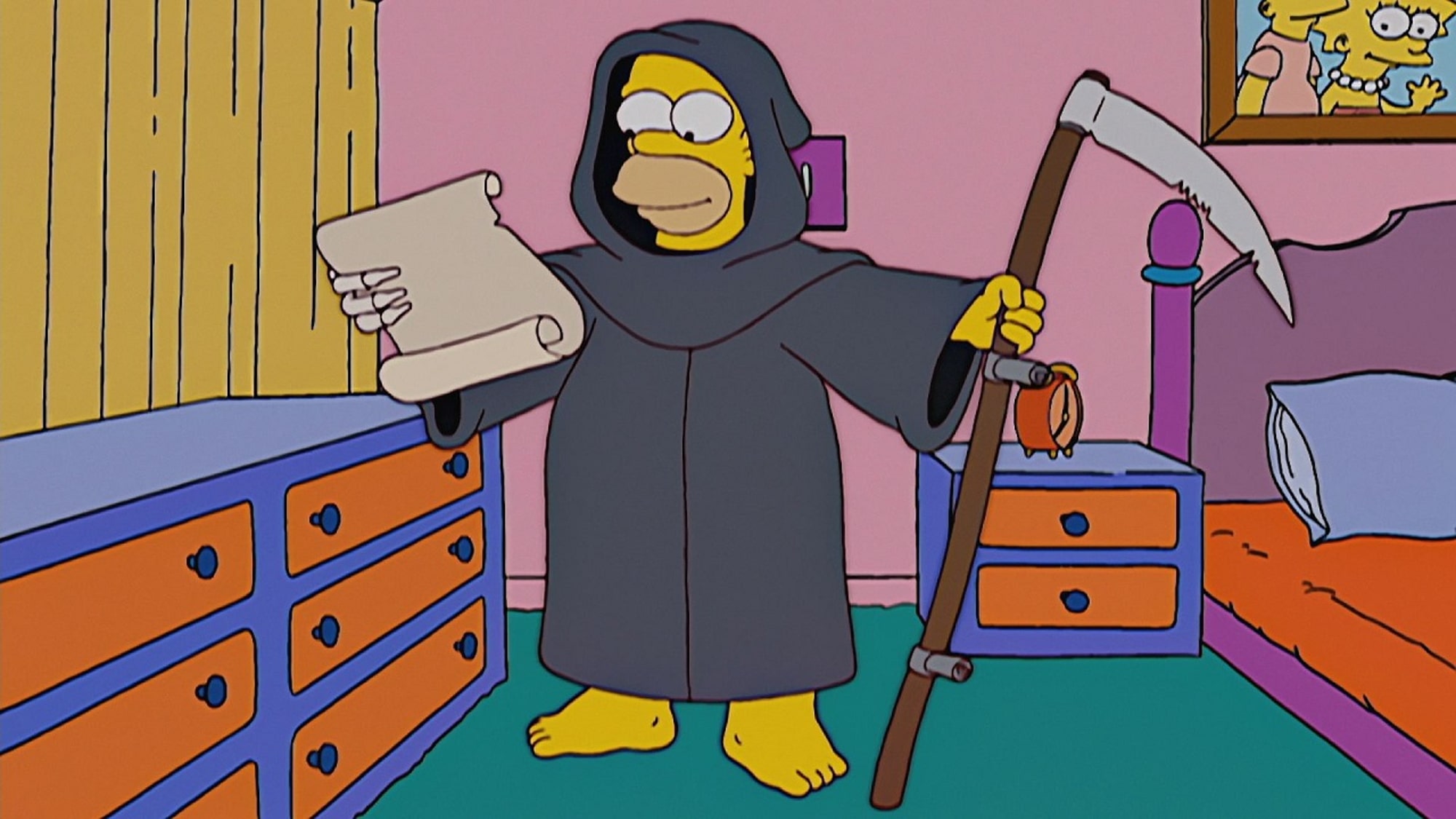On the surface, the Simpsons “Reaper Madness” segment isn’t actually all that noteworthy. Sure, it helped kick off season 15, something that definitely seems like a milestone, but many agree that the series had generally begun its downward decline by that point anyway. Yes, it’s a funny parody of classic horror, but all Treehouse of Horror segments fall under that classification.
What makes “Reaper Madness” unique is its treatment of death. By personifying death as a real character, the segment is able to poke fun at horror media that parallels the episode in a literal sense as well as horror media that parallels the episode in a figurative sense. This dichotomy is important here, and it allows “Reaper Madness” to be one of the few Treehouse of Horror segments that really makes the audience question horror tropes rather than just laugh at them.
But before we get into that, though, why not go over a quick summary?
Summary of The Simpsons “Reaper Madness”
Bart’s time has come – or, at least, that’s the premise of the beginning of “Reaper Madness.” As the Simpsons are relaxing at home, a knock on the door signals the arrival of the Grim Reaper. Bart is next up on his list, and it’s time for him to die. Although it seems only right for the little twerp to finally get his comeuppance, it’s not that simple. The Grim Reaper has to make it through a Benny Hill-style chase scene complete with music first.
Eventually, though, he gets El Barto cornered. Is it truly the end? Will his shorts get eaten for the last time? Well, no. Homer acts as the boy’s deus ex machina, appearing from behind and smashing the Grim Reaper’s skull with a bowling ball. With that, the entire concept of death is completely eliminated from the world – even Moe’s desperate attempt at suicide simply leaves him hanging from the rafters while still perfectly alive. (You may be noticing what is actually a common theme here: hilarious segments from the episodes become surprisingly dark when you type them out.)
Naturally, life (and the lack of death) can’t go on like this. Fate has it that Homer tries on the Grim Reaper’s hand-me-down robes, and this converts him into the new taker of souls. His new job has him killing people all across Springfield, and it doesn’t pose any major issues for a bit. If anything, Homer seems well-suited to the change in career paths. To be fair, though, Homer’s pretty used to working random one-off jobs.
But then, a bombshell: the next on the Grim Reaper’s list is Marge Simpson.

At first, Homer tries bargaining, but the only way to save Marge is to sacrifice himself. No, that won’t do. Instead, he comes up with a brilliant plan: he will kill Patty, tape Marge’s hair to her head, and then bring Patty to the top of a mountain and offer her as a sacrifice to God to make it seem as though he’s actually killed Marge. After he runs up that hill, he then makes a deal with God: since he killed the love of his life, he should get to be freed from his vocation as Grim Reaper. Before God realizes his mistake, he grants Homer his wish, and he speeds off on a motorcycle. Nice.
Thankfully, The Simpsons “Reaper Madness” has a happy ending. Homer is back to normal, and aside from her trademark hair being chopped by a scythe, Marge is unscathed. Thus ends the first segment of “Treehouse of Horror XIV.”
Death as a Character… Literally
The most obvious trope being played on here is that of Death with a capital D. Death has taken literal forms in art since, uh, the dawn of art more or less, but it’s very popular in horror and the Gothic.
The Grim Reaper, in fact, is a relatively popular character despite always playing second fiddle to heavy-hitters like zombies and werewolves.
The Grim Reaper was making appearances in horror movies before horror movies were even really a thing. The atmospheric 1921 film The Phantom Carriage prominently features the Grim Reaper in a form that we are all familiar with, complete with dark cloak and razor-sharp scythe. The film even makes incredibly creative and influential use of double-exposures to imprint a ghastly vision of the Reaper onto other scenes. Creepy!

Interestingly enough, though, the Grim Reaper often doesn’t quite have the horrifying impact that we all expect him to have. Just like in “Treehouse of Horror,” the Grim Reaper can be found in multiple movies that blend horror and comedy. The Frighteners, Cemetery Man, and more all poke fun at our fear of death by presenting the Grim Reaper in exaggerated, comical scenarios.
Actually, a literal personification of Death might be more common in pure comedy than in horror: Monty Python’s the Meaning of Life and Bill and Ted’s Bogus Journey both prominently show that the Grim Reaper just ain’t that scary these days. Maybe the Simpsons “Reaper Madness” segment was really onto something.
But still, it’s hard to fully discount the idea of the Grim Reaper being scary. After all, he represents death, and what’s scarier than death? (I’ll answer that for you: public speaking.) The key here is that a physical, humanoid personification of death like the Grim Reaper makes the concept too approachable and familiar. When abstracted, though, death is still mighty terrifying.
Death as a Character… Figuratively
Okay, so the show absolutely used Death as a literal character in their episode. However, death as a concept is just as important as Death in the form of the Grim Reaper. During this brief segment, Homer as Death and Homer as the concept of death begin to blur together. His gleeful, opportunistic murdering at first feels like Homer just making use of a new tool at his disposal – but later on, when he needs to consider taking the life of his one true love, it feels like the line between Homer and death as a concept begins to blur. Power corrupts… and so too does death.
This is what allows the episode to pack an extra punch. Not only are we laughing about the Grim Reaper, but we are laughing about death in general. It’s something that is always hiding in the back of our minds, and it feels good to giggle about it. This parodying of the concept of death isn’t just a coincidence, either – it’s actually another instance of “Treehouse of Horror” masterfully deconstructing a common theme in horror.
No matter where you look in the genre, death is everywhere. Sure, a one-off death doesn’t necessarily raise the concept to the status of personification, but many horror movies take the extra step to make the pervasiveness of death into its own character. Take the Final Destination series, for example. We never see the Grim Reaper step out from behind a corner, but it’s clear that he’s there in spirit, haunting every interaction that occurs.
— FOUNDATIONS OF HORROR —
Further explore these subgenres & tropes. more>>
#The Simpsons | #Zombie horror | #Gothic horror

Another great example of this can be seen in any traditional zombie movie. If just one zombie were to chase the protagonists, it would just be a movie about zombies. But what is truly chilling about zombies is how the individuals blur when placed in a horde, and it no longer is just about being pursued by creepy ghouls yelling out, “Braaaains.” No, it’s about being pursued relentlessly by the slow, unavoidable approach of death.
Wrestling with our mortality in that way is far scarier than seeing it take the form of a guy in a cloak. It Follows has a few great jump scares, but what kept me up at night was the psychological torture that the characters had to endure while constantly having to look over their shoulders for death in whatever form it took. In a way, that’s how many of us are living… but that’s a discussion for another day.
Do I think that The Simpsons “Reaper Madness” segment was about this trend in horror media to give death a life of its own (ha!)? Honestly, yeah. If you think about it, death is the most pervasive character in all of horror. How could they not want to parody that?
Last Updated on August 26, 2022.

